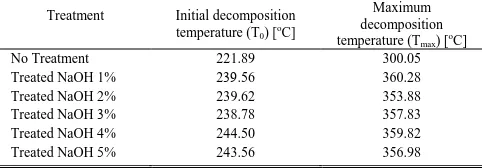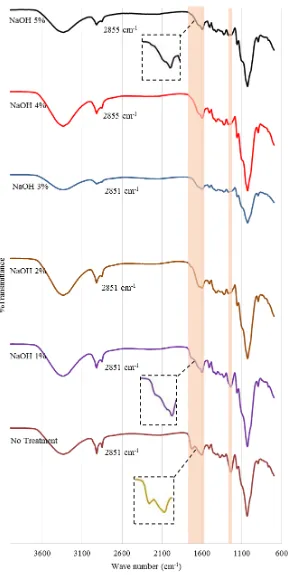Abstract—This article reports an investigation of the decomposition temperature of fibres from empty oil palm bunch to achieve improved understanding of the processing temperature limitation of this fibre as reinforcement for thermoplastic composite manufacturing. The effect of alkaline treatments on their chemical decomposition and sample weight changes were performed, using fourier transform infrared spectrometry (FTIR) and thermogravimetry (TG) techniques. The results show that the hemicellulose removal of fibres after treatment is a factor that provides an advantage on the thermal stability of the fibres. Both initial decomposition temperature (T0) and maximum decomposition temperature
(Tmax) are minor increase. This could reduce the detrimental
effect of thermal degradation on the single fibre performance and leads to shift its consolidation temperature ceiling from below 221oC (untreated fibres) to 243oC (5% NaOH treated fibres) during composite consolidation.
Index Terms— alkaline treatment, natural fibres
I. INTRODUCTION
HE plant fibres, such as oil palm bunch, cotton and flax, are renewable, low density and biodegradable materials, and can be used as reinforcement in the manufacturing of thermoplastic composites [1]. In addition, these eco-friendly materials have provided attractive replacement of glass fibres in terms of specific properties, although currently there are several disadvantages of using plant fibres as reinforcement materials due to high process temperature of melted thermoplastic matrix [2]. The fibres from empty oil palm bunch, like other plant fibres, have various physical constituents, which result in poor composite properties due to their thermal degradation at high consolidation temperature [3, 4]. The chemical composition of oil palm bunch is similar to that of wood.
In this work, the focus is on the decomposition temperature of fibres studies of oil palm bunch fibre to improve understanding of the influence of temperature on its thermal stability under alkaline treatment for process determination of the thermoplastic composite
Manuscript received December 20, 2018. This work was supported the Agricultural Research Development Agency (Public Organization) (ARDA) Thailand for financial support and Suksomboon Palm oil co.,Ltd., Chonburi province, Thailand for empty oil palm bunch material support.
Jedsada Chaishome is with Department of Food Engineering, Faculty of Engineering, King Mongkut’s Institute of Technology Ladkrabang, Bangkok, Thailand. (e-mail: jedsada.ch@kmitl.ac.th).
Navaphattra Nunak is with Department of Food Engineering, Faculty of Engineering, King Mongkut’s Institute of Technology Ladkrabang, Bangkok, Thailand. (e-mail: navaphattra.nu@kmitl.ac.th).
manufacturing. Fourier transform infrared spectrometry techniques and thermogravimetry were used to investigate the chemical composition and weight change of the oil palm bunch fibres, respectively.
II.MATERIALS AND EXPERIMENTAL METHOD
Before the decomposition temperature of fibres studies, the fibres were examined to define fibre density and fibre hydration levels.
A.Materials
The untreated fibre material from empty oil palm bunch was supported from Suksomboon Palm Oil co.,Ltd., Chonburi province, Thailand. The fibres were heated at 120oC for 12 hours, then keep in a storage room.
B.Treatment
Fibres were dipped in NaOH solution (1, 2, 3, 4, 5% by weight) for 20 minutes at room temperature. Accordingly, these fibres were washed in running water several times and dried 80o C for 12 hours.
C.Fourier transform infrared spectrometry (FTIR)
FTIR technique was used to investigate the chemical composition changes of treated and untreated fibres. The spectrum of the fibres was performed using a Shimadzu IRPrestige-21spectrometer, between 700 and 3,700 cm-1 frequency range.
D.Thermogravimetric analysis (TGA)
The decomposition temperature of treated and untreated oil palm fibres was examined with TGA technique. The fibres were weighted of 10 mg and tested under argon atmosphere. Thermogravimetric (TG) and differential thermogravimetric (DTG) curves were recorded. These experiments were examined using a Setaram Labsys evo TG/DTA, TG/DSC thermal analyser. An argon flow rate of 20 ml/min was used between 25 and 600oC at heating rates of 10oC/min with an argon pre-heating process for 15 minutes.
III. RESULTS AND DISCUSSION
A.Fibre density and moisture content
Untreated fibres from empty oil palm bunch were found to have a fibre density of 0.99 g/cm3. This result was in a range of values reported for oil palm fibres in other studies which were generally in the range 0.70 – 1.60 g/cm3 [5].
Effect of Alkaline Treatment on Decomposition
Temperature of Fibres from Empty Oil Palm
Bunch
Jedsada Chaishome1* and Navaphattra Nunak2
This is useful value for calculating fibre volume fraction and specific properties of the composite.
[image:2.595.307.548.614.698.2]The fibres are hydrophilic material and can absorb moisture from atmosphere. Fig. 1 presents the drying rate of moist fibres during the drying process of 140oC. The average initial moisture content was 10.04% for arbitrary storage RH. It can be seen that a drying time of 60 minutes is an appropriate choice. Furthermore, this drying process will be a fibre preparation process before forming, reducing voids in the composites from water evaporation entrapment during layup.
Fig. 1. Moisture content as a function of time during a drying process at 140oC
B.Effect of alkaline treatment on the chemical decompositions of fibres.
The transmittance bands of fibres from empty oil palm bunch in expression of their functional group wave number were shown in Fig. 2. Spectrums acquaint with the transmittance bands of chemical group characteristics of water, lignin, pectin, hemicellulose and cellulose substances of material without treatment.
A number of presence peaks observed confirms their existence of both cellulose and lignin before and after treatment. The spectrum range 3600 – 3100 cm-1 were attributed to the OH stretching of methanol and cellulose. A peak at 2916 cm-1 was attributed to the alkyl, aliphatic and aromatic in cellulose. A peak at 22851 cm-1 was attributed to the C-Hn stretching of cellulose. A peak of 1608 cm-1 was attributed to the water from moist fibres. Wave numbers of 1512, 1423, 1327 and 1161 cm-1 peak were attributed to the C=C stretching of lignin, CH symmetric bending of cellulose, C-O bending of aromatic rings in polysaccharides in cellulose and anti-symmetrical deformation of the C-O-C in lignin, respectively.
More important, a number of invisible peaks observed infers to their fibres chemical composition removal after treatment. A peak at 1724 cm-1 was attributed to the C=O stretching in hemicellulose and Methyl ester and Carboxylic acid in pectin. A peak at 1238 cm-1 was attributed to the C-H bending in hemicellulose. This analogism could be concluded that both hemicellulose and pectin were removed after alkaline treatment, particularly
higher concentration of alkaline.
C.Effect of alkaline treatment on the decomposition temperature of fibres.
Fig. 3. shows weight loss (TG), its derivative (DTG) and second derivative (D2TG) curves of fibres heating from 25oC to 600oC at 10oC/min heating rate. Table 1 shows the decomposition temperature of the fibre from Empty Oil Palm Bunch determined from these tests. DTG curve reveals to water vaporization from moist fibres between the temperature of 25 and 140oC.
Their drying rate were much lower than fibre moisture content as described in section 3.1, possibly due to a pre-heating process for 15 minutes of air releasing in thermogravimetric analyzer. Argon was used to remove the air inside the fibre chamber and could dehydrate the fibres. After dehydration, a shoulder peak between 220 and 320oC distributed to is the temperature of the thermal de-polymerisation of glycosidic linkages of cellulose, pectin and hemicellulose [6-10]. Finally, the main peak (a range of 275 to 400oC) attributed to cellulose decomposition with high weight loss [11-14].
The initial decomposition temperature (T0) and the
maximum decomposition temperature (Tmax) were
calculated from the DTG and second time derivatives (D2TG) curves, as described in Yao et al.’s report [15] and were shown in Table I. The results from this study reveal that the untreated fibres would be stable until 221.89oC and start to degrade rapidly. Nevertheless, fibre treatment could shift its T0 and Tmax to higher temperature. For instance,
221.89oC and 243.56oC of T0 for no treated and 5% of
NaOH treatment, respectively, and 300.05oC and 356.98oC of Tmax for no treated and 5% of NaOH treatment,
respectively.
From an engineering perspective, many steps processing of composite manufacturing are required, prior to treatment, in order to fulfill higher mechanical performance of single fibres and consequently reinforced composites. A small increase of composite processing temperature (only 17.67oC increased from 221.89 of untreated fibres to 239.56oC) could not be useful due to most thermoplastics have their melting point lower than 220oC.
TABLEI
DECOMPOSITION TEMPERATURES OF
TREATED AND UNTREATED FIBRES FROM EMPTY OIL PALM BUNCH
(HEATING RATE OF 10O
C/MIN UNDER ARGON ATMOSPHERE)
Treatment Initial decomposition temperature (T0) [oC]
Maximum decomposition temperature (Tmax) [oC] No Treatment
Treated NaOH 1% Treated NaOH 2% Treated NaOH 3% Treated NaOH 4% Treated NaOH 5%
[image:4.595.71.528.47.594.2]
Fig. 3. The thermogravimetric analysis curves of fibres; (a) No treatment, (b) NaOH 1%, (c) NaOH 2%, (d) NaOH 3%, (e) NaOH 4%, (f) NaOH 5%
Furthermore, more alkaline and processing requirement consume operation time and cost. On the other hand, a process with its consolidation temperature lower than T0
(lower than 221.89oC) of composite processing, the fibre from Empty Oil Palm Bunch performance would be still not changed. High performance of plant fibre reinforced thermoplastic composites would actually achieve the same advantage composites.
IV. CONCLUSION
This article reports on the influence of alkaline treatment on decomposition temperature of fibres from empty oil
temperature of a forming process of fibre reinforced thermoplastic composites. The results can be concluded as follows:
A reduction of hemicellulose and pectin from the fibre after treatment.
The alkaline treatment results in a shift of the main degradation temperature of fibre materials to higher temperature.
ACKNOWLEDGEMENTS
The authors gratefully acknowledge the Agricultural Research Development Agency (public organization) (ARDA) Thailand for research funding and Suksomboon Palm oil co.,Ltd., Chonburi province, Thailand for empty oil palm bunch material support.
REFERENCES
[1] J. Chaishome and S. Rattanapaskorn, "The influence of alkaline treatment of plant fibres on tensile properties of single fibres and composites," in 1st International Conference on Frontiers of Composite Materials, ICFCM 2016 vol. 894 MSF, R. K. Agarwal, Ed., ed: Trans Tech Publications Ltd, 2017, pp. 46-49.
[2] E. Sritham, et al., "Tensile properties of PLA/PBAT blends and PLA fibre-reinforced PBAT composite," in MATEC Web of Conferences, 2018.
[3] C. Baillie, Green composites Polymer composites and the environment, 1 ed. Boca Raton New York Washington, DC: Woodhead Publishing Ltd and CRC Press LLC, 2004.
[4] J. Gassan and A. K. Bledzki, "Thermal degradation of flax and jute fibers," Journal of Applied Polymer Science, vol. 82, pp. 1417-1422, 2001.
[5] O. Faruk, et al., "Biocomposites reinforced with natural fibers: 2000-2010," Progress in Polymer Science, vol. 37, pp. 1552-1596, 2012.
[6] J. Chaishome and S. Rattanapaskorn, "The influence of alkaline treatment on thermal stability of flax fibres," in 2017 2nd International Conference on Mining, Material and Metallurgical Engineering, ICMMME 2017, 2017.
[7] I. M. De Rosa, et al., "Morphological, thermal and mechanical characterization of okra (Abelmoschus esculentus) fibres as potential reinforcement in polymer composites," Composites Science and Technology, vol. 70, pp. 116-122, 2010.
[8] J. Chaishome, et al., "Thermal degradation of flax fibres as potential reinforcement in thermoplastic composites," in 2014 4th International Conference on Advanced Materials Research, ICAMR 2014 vol. 894, ed. Macau, 2014, pp. 32-36.
[9] J. Chaishome and S. Supapvanich, "Polylactic acid (PLA) based green composites reinforced pineapple leaf fibres: Evaluation of processing and tensile performance," in MATEC Web of Conferences, 2018. [10] I. M. De Rosa, et al., "Mechanical and thermal
characterization of epoxy composites reinforced with random and quasi-unidirectional untreated Phormium tenax leaf fibers," Materials & Design, vol. 31, pp. 2397-2405, 2010.
[11] I. M. De Rosa, et al., "Tensile behavior of New Zealand flax (Phormium tenax) fibers," Journal of Reinforced Plastics and Composites, July 6, 2010 2010.
[12] H. Yang, et al., "Characteristics of hemicellulose, cellulose and lignin pyrolysis," Fuel, vol. 86, pp. 1781-1788, 2007.
[13] S. Wong, et al., "Interfacial improvements in poly(3-hydroxybutyrate)-flax fibre composites with hydrogen
bonding additives," Composites Science and Technology, vol. 64, pp. 1321-1330, 2004.
[14] M. Gao, et al., "Thermal Degradation of Wood Treated with Amino Resins and Amino Resins Modified with Phosphate in Nitrogen," Journal of Fire Sciences, vol. 22, Nov 1, 2004 2004.


